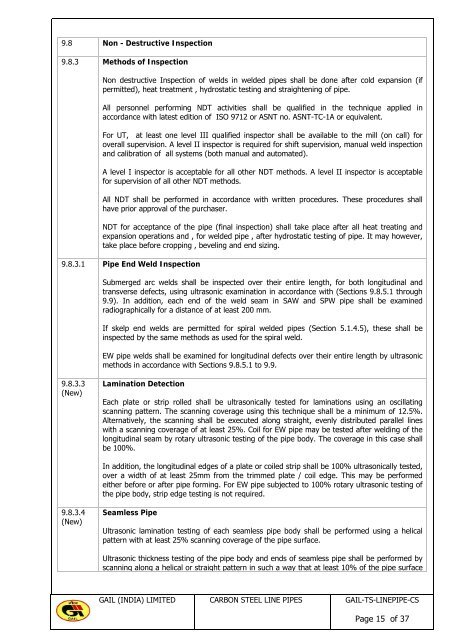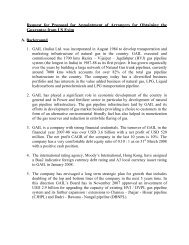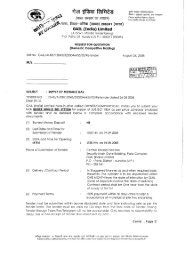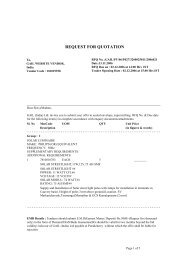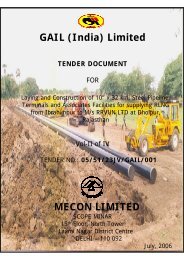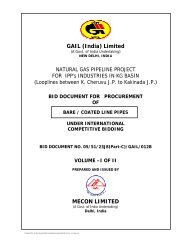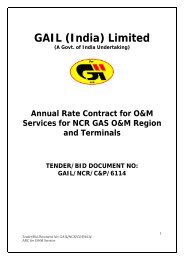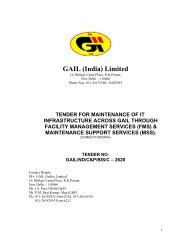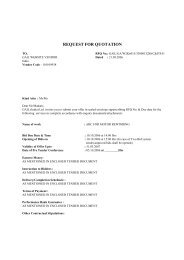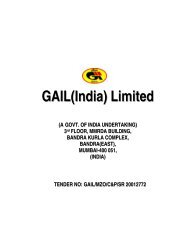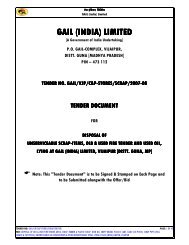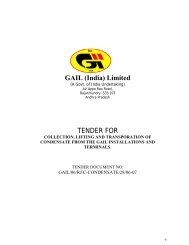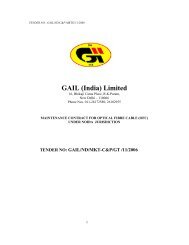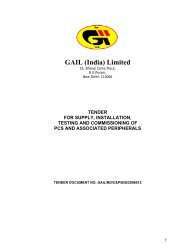Volume-II - GAIL
Volume-II - GAIL
Volume-II - GAIL
You also want an ePaper? Increase the reach of your titles
YUMPU automatically turns print PDFs into web optimized ePapers that Google loves.
9.8 Non - Destructive Inspection<br />
9.8.3 Methods of Inspection<br />
Non destructive Inspection of welds in welded pipes shall be done after cold expansion (if<br />
permitted), heat treatment , hydrostatic testing and straightening of pipe.<br />
All personnel performing NDT activities shall be qualified in the technique applied in<br />
accordance with latest edition of ISO 9712 or ASNT no. ASNT-TC-1A or equivalent.<br />
For UT, at least one level <strong>II</strong>I qualified inspector shall be available to the mill (on call) for<br />
overall supervision. A level <strong>II</strong> inspector is required for shift supervision, manual weld inspection<br />
and calibration of all systems (both manual and automated).<br />
A level I inspector is acceptable for all other NDT methods. A level <strong>II</strong> inspector is acceptable<br />
for supervision of all other NDT methods.<br />
All NDT shall be performed in accordance with written procedures. These procedures shall<br />
have prior approval of the purchaser.<br />
NDT for acceptance of the pipe (final inspection) shall take place after all heat treating and<br />
expansion operations and , for welded pipe , after hydrostatic testing of pipe. It may however,<br />
take place before cropping , beveling and end sizing.<br />
9.8.3.1 Pipe End Weld Inspection<br />
9.8.3.3<br />
(New)<br />
9.8.3.4<br />
(New)<br />
Submerged arc welds shall be inspected over their entire length, for both longitudinal and<br />
transverse defects, using ultrasonic examination in accordance with (Sections 9.8.5.1 through<br />
9.9). In addition, each end of the weld seam in SAW and SPW pipe shall be examined<br />
radiographically for a distance of at least 200 mm.<br />
If skelp end welds are permitted for spiral welded pipes (Section 5.1.4.5), these shall be<br />
inspected by the same methods as used for the spiral weld.<br />
EW pipe welds shall be examined for longitudinal defects over their entire length by ultrasonic<br />
methods in accordance with Sections 9.8.5.1 to 9.9.<br />
Lamination Detection<br />
Each plate or strip rolled shall be ultrasonically tested for laminations using an oscillating<br />
scanning pattern. The scanning coverage using this technique shall be a minimum of 12.5%.<br />
Alternatively, the scanning shall be executed along straight, evenly distributed parallel lines<br />
with a scanning coverage of at least 25%. Coil for EW pipe may be tested after welding of the<br />
longitudinal seam by rotary ultrasonic testing of the pipe body. The coverage in this case shall<br />
be 100%.<br />
In addition, the longitudinal edges of a plate or coiled strip shall be 100% ultrasonically tested,<br />
over a width of at least 25mm from the trimmed plate / coil edge. This may be performed<br />
either before or after pipe forming. For EW pipe subjected to 100% rotary ultrasonic testing of<br />
the pipe body, strip edge testing is not required.<br />
Seamless Pipe<br />
Ultrasonic lamination testing of each seamless pipe body shall be performed using a helical<br />
pattern with at least 25% scanning coverage of the pipe surface.<br />
Ultrasonic thickness testing of the pipe body and ends of seamless pipe shall be performed by<br />
scanning along a helical or straight pattern in such a way that at least 10% of the pipe surface<br />
<strong>GAIL</strong> (INDIA) LIMITED CARBON STEEL LINE PIPES <strong>GAIL</strong>-TS-LINEPIPE-CS<br />
Page 15 of 37


